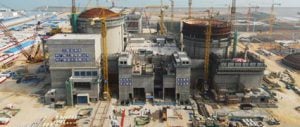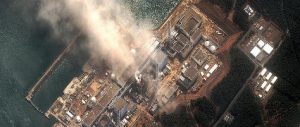It took the recent crisis at the Fukushima nuclear plant in Japan to make atomic energy a topic for public discussion in China. Safety issues have been at the core of that debate. China’s ambitious nuclear power programme, further codified in the 12th Five-Year Plan, suddenly began to panic ordinary people. It became even worse when officials or industry experts attempted to offer their explanations. Poor communications strategies – and widespread public distrust of experts – meant that confidence in the technology only declined. Nuclear experts needed to justify their work to the sceptical public for the first time, leaving them frustrated with what they perceived as a scientifically illiterate Chinese public.
The incident at Fukushima almost coincided with the 25-year anniversary of the Chernobyl disaster in the Ukraine [Editor’s note: the unfortunate anniversary is today. Also read “Forget Chernobyl at our peril” by John Vidal and “Chernobyl – a poisoned landscape” by Robin McKie.]. The Heinrich Böll Foundation, affiliated with the German Green Party [the author is a project officer at their Beijing office], has published a series of reports about nuclear power to mark that historic anniversary, looking at the use of nuclear power in terms of its economics, the effect on weapons proliferation and its comparison with renewable energy sources.
The reports did not only focus on safety: this is but one variable in the overall analysis. This may be because Europe has seen a lot more debate about nuclear safety than China in the last few decades – and also because the urgency of addressing climate change has changed the terms of the discussion about atomic energy. Either way, the facts in these reports provide a useful counterpoint to the firm beliefs of some regarding the safety and viability of nuclear power.
One report, The Economics of Nuclear Power: An Update, by Steve Thomas, emphasises the costs of nuclear safety. Safety is why the cost of nuclear power stations has increased fivefold in the last decade: banks will not take on the risks associated with funding nuclear-power stations. For example, six of Wall Street’s largest investment banks told the US Department of Energy that unless taxpayers underwrite 100% of the risks, they will not lend to new nuclear projects. The report also finds that where the power sector is a regulated monopoly, the real cost of capital will be relatively low – 5% to 8%. But where there is a competitive market, the cost of capital will be much higher – at least 15%.
Meanwhile, the costs of constructing a nuclear power plant – not including decommissioning costs, or the processing and handling of nuclear waste – represent 70% of total costs. International experience suggests that modern reactors require huge on-site construction, for which cost control is problematic – it often runs over budget. The designs may be changed during construction – for example, new designs may have not been certified when construction started, or an accident at an existing plant may require changes to those being built. Delays are also common. There seems to be little “learning curve” or indeed “economy of scale” in nuclear power.
The author concludes that while nuclear power plant designs can in theory meet the safety standards of regulators, the costs are prohibitive. Nuclear power plants can only be built when the government is prepared to ignore the results of public consultation and provide large subsidies. Moreover, the bills for decommissioning and dealing with nuclear waste are also left for the taxpayer to pick up.
There are huge opportunity costs associated with investing in nuclear power instead of renewable energy. In another report, Systems for Change: Nuclear Power vs. Energy Efficiency + Renewables?, by Antony Frogatt and Mycle Schneider, the authors argue that in the first 15 years of their development in the United States both nuclear and wind power produced large amounts of energy – 2.6 billion kilowatt-hours in the case of nuclear, 1.9 billion for wind – but nuclear power received 40 times as much money in subsidies (US$39.4 billion, as opposed to $900 million). The report concludes that nuclear power spends huge amounts of money that could otherwise be invested in cleaner, faster-to-develop sources of renewable energy.
As for the common view that nuclear energy is a large and stable producer of energy, the authors point out that such large, centralised power generation often produces surplus energy that cannot be saved. Increasing renewable-energy generating capacity requires flexible, medium-load infrastructure, rather than inflexible heavy-load power generating plants. In their vision for low-carbon generation, the authors suggest bi-directional grids so that energy consumers can also store and send power back to the grid. The smart meters and grids for this are already under development.
Finally, nuclear power can also present a threat to security and social stability. This is the conclusion of Nuclear Weapons and Nuclear Energy-– Siamese Twins or Double Zero Solution, Otfried Nassauer. Of course, atomic energy and nuclear weapons are different things, but there is little difference between refining uranium for civil and military applications – the former can easily be adapted for the latter use.
It is hard to tell during the early stages of civil nuclear programmes if there are concealed military aims. Nuclear weapons programmes in France, Israel, North Korea and South Africa all started with civil nuclear programmes. There is a lack of international consensus about whether Iran’s nuclear programme is peaceful or not. The report suggests, therefore, that there is a contradiction between two of US president Barack Obama’s stated intentions: on the one hand to reduce nuclear proliferation, while on the other to expand the peaceful use of atomic energy. Even if there were no safety issues with the storage and handling of spent nuclear fuel or the safety and security of nuclear power plants, the expansion of nuclear power means the spread of nuclear materials and related technical knowledge.
Given the security situation in the world today, it is hard to be sure that nuclear know-how or materials will not fall into the hands of extremists, especially where there are unstable governments. There is the risk, for example, of someone constructing a “dirty bomb” that uses radioactive materials. Some incidents in China have shown us that even seemingly ordinary citizens can, in extreme circumstances, take terrible vengeance on society at large.
Therefore, there are more issues at stake than just the safe operation of nuclear power plants. People should not ignore other issues, such as social stability, the environment and economic sustainability. China’s policy-makers and nuclear experts are probably confident in the safe operation of China’s nuclear power sector. But the development of nuclear power is not only a technical issue: if we do not take economic, environmental and social factors into account in the decision-making process, we risk losing the confidence of the public – and may make them shoulder difficult long-term risks.
Chen Jiliang is project officer with the Heinrich Boell Foundation’s Beijing office.
Homepage image from Greenpeace


